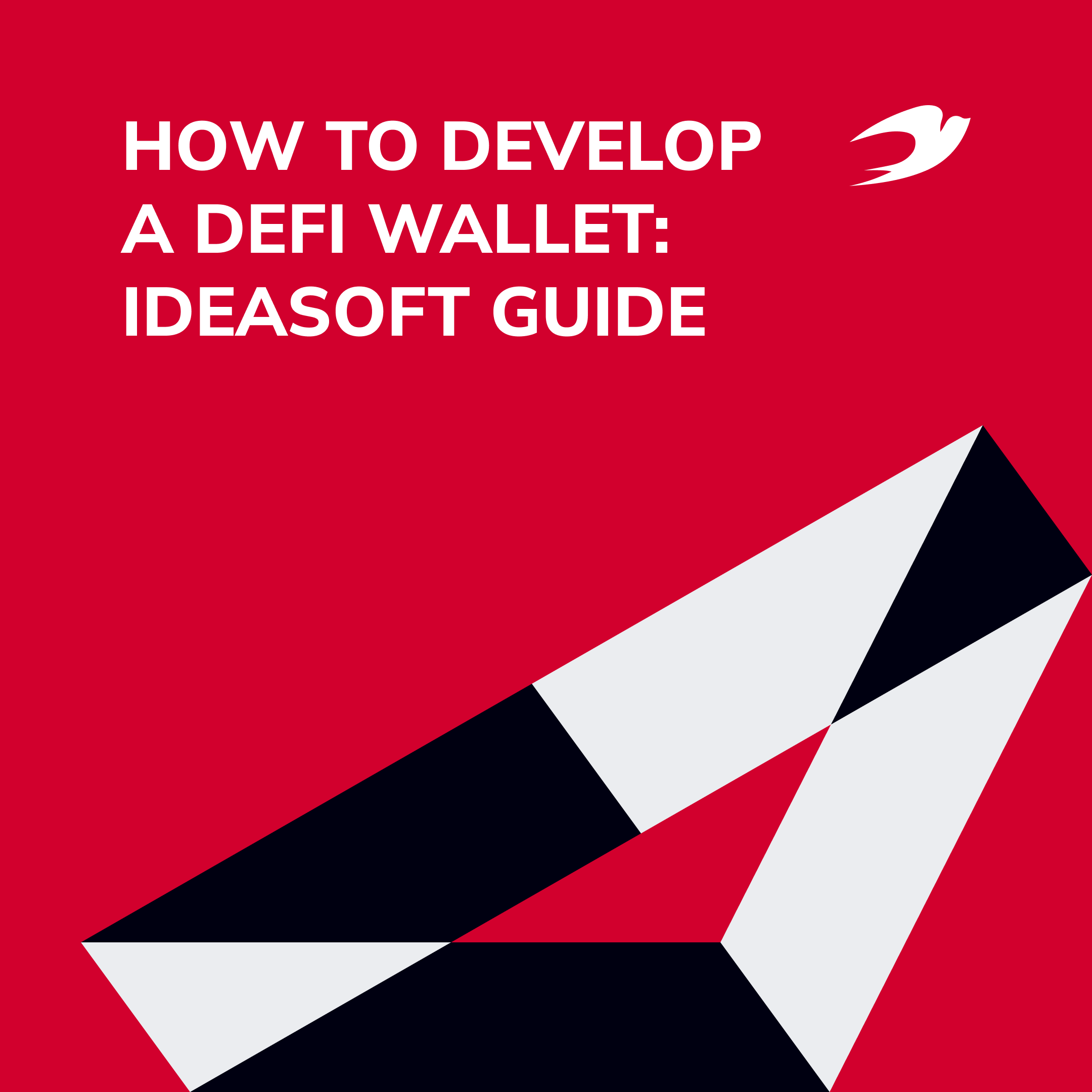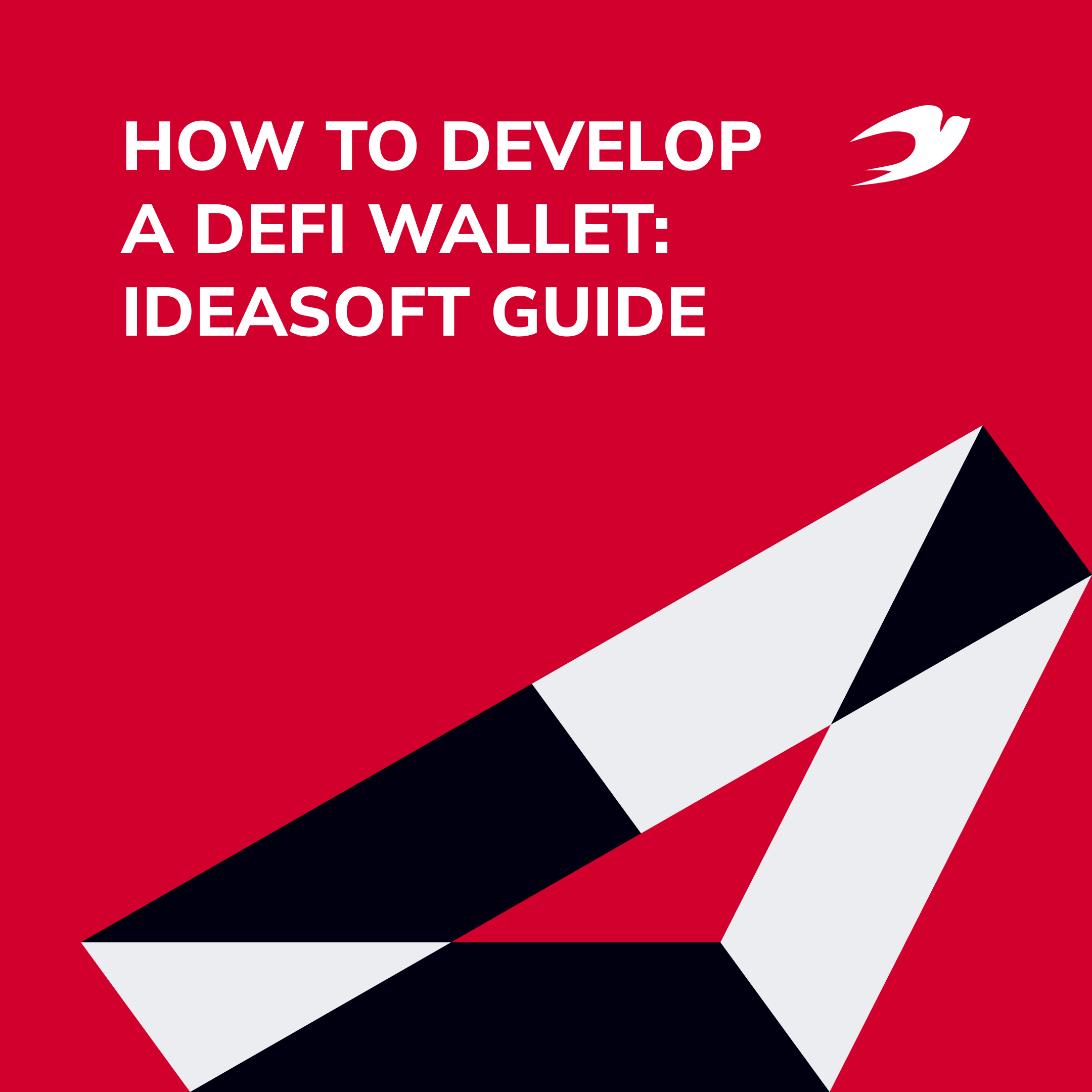Despite concerns about DeFi in its early days, it seems that decentralized finance has firmly taken its place in the market. Users have started to appreciate the many benefits of DeFi such as transparency, autonomy, availability, and elimination of third parties. The main bridge between DeFi platforms and users is DeFi wallets, which provide a completely new and improved user experience for their owners. In this article, we will explain how to develop a DeFi wallet, one of the most popular types of DeFi projects.
Table of contents:
- The difference between custodial and non-custodial wallets
- Key features of DeFi wallets
- Steps for creating a DeFi wallet
- Examples of DeFi wallets
- How we can help
The difference between custodial and non-custodial wallets
First of all, let’s start by defining a DeFi wallet to understand how it works and how it differs from a regular crypto wallet.
A DeFi wallet is a non-custodial wallet which means you get full control over your crypto private keys. This ensures that you are 100% responsible for managing your own funds. Unlike the centralized wallets offered by exchanges like Coinbase and Binance, which store your funds on exchange accounts, with DeFi wallets, the users are the sole owners of their assets. Also, in order to store and manage funds with a DeFi wallet, you don’t need to provide information about yourself and go through checks and verifications. Even when participating in DeFi projects, platforms will interact only with the wallet and its public address without disclosing personal data.
Take a closer look at the main features of custodial and non-custodial wallets.
| Feature | Custodial wallet | Non-custodial wallet |
| Control over funds | Custodian or third-party | Users |
| Security | Less secure since keys are stored by third-party | Extremely secure since users store their private keys |
| Account restore | Can be restored | Can’t be restored |
| Withdrawal process | Slower due to KYC/AML checks | Faster |
| Transaction fees | Lower or even free within the same ecosystem | User pays a full transaction fee |
| Usability | More user-friendly | Less user friendly |
As you can see, non-custodial wallets are more secure and give users more freedom to store and manage their funds. However, along with this comes additional responsibility. If the user loses the keys to their crypto wallet, the funds cannot be recovered. Also, custodial wallets are often more user-friendly than decentralized ones, so you should pay extra attention to creating a high-quality and user-friendly interface when developing a DeFi wallet.
Key features of DeFi wallets
When creating a DeFi wallet, the first thing you need to do is to draw up a list of the features you want to implement in your product. As you can guess, whether it will be popular among users directly depends on the functionality and convenience of your application. Start with the basic features your wallet should have.
- Fast and easy sign-up. Remember, one of the main benefits of DeFi is privacy. Let your users quickly get started with the wallet by setting a username and choosing their security settings like a passcode or biometric security.
- Balance check. This is a basic feature for any digital wallet. One of the best practices is to display balances on the start screen so that users can always see them.
- Send/receive crypto. Your app should provide both convenient transfer and receipt of crypto funds. For example, Coinbase Wallet allows you to send cryptocurrency in several ways: by scanning a QR code, entering a long-form address or using a Coinbase Wallet’s username.
- Money withdrawal. Withdrawals are also a must-have feature for any crypto wallet. Make sure users won’t face difficulties with withdrawals. Also, don’t forget to add a help button so that users can quickly contact you if something goes wrong.
- Transaction history. Transaction history helps users analyze their activity. Make sure to add some filters so that users can track their expenses and income in the best way (by time, type of transaction, asset type, etc.).
- Notifications. Push notifications can be really useful if you make sure they don’t become annoying. Allow users to independently choose which notifications they want to receive. For example, messages about crediting funds, updates, news, etc.
This is not a complete list of features that users of your DeFi wallet can benefit from. The more personalized and unique the experience is that you provide, the more likely your app will stand out from the competition and come out on top. For example, you can create a chatbot that will help users quickly resolve their requests. Another idea is to provide a lending option so users can start earning interest without leaving their wallets. The best option is to research the needs of your target audience to see how you can meet them.
Steps for creating a DeFi wallet
DeFi product development differs in some ways from the development of conventional centralized solutions. All operations on DeFi platforms are powered by self-executing smart contracts. And building secure and functional smart contracts requires good blockchain expertise. Therefore, no matter how familiar you are with blockchain technology, we advise you to enlist the support of an experienced development team who not only knows how to develop a DeFi wallet but also has a portfolio of successfully implemented DeFi projects.
The process of creating a DeFi wallet consists of several stages. Before your development team starts coding, you need to decide on the business part and design of your app. So here are the main steps used to create a DeFi wallet.
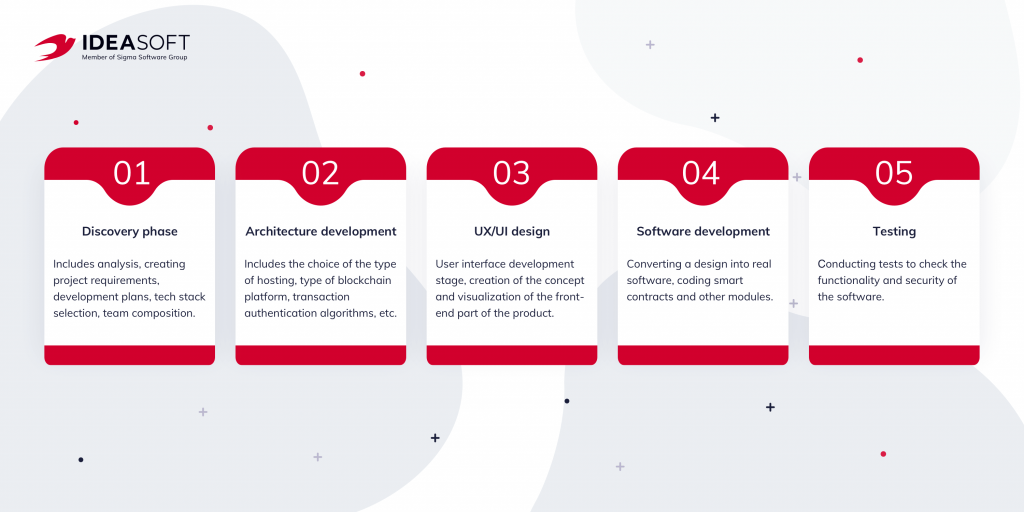
Discovery phase
The discovery phase is carried out in order to determine the goals of the project, its target audience, risks, etc. In order to succeed you need to create an app that will be useful to its potential users. Market analysis will reveal the needs of your potential customers. The competition in the DeFi market is getting stronger as new platforms quickly emerge, so before you start the DeFi wallet development process you should also know which apps are already popular and how you can stand out.
During the discovery phase, business analysts will help you make a list of features and draw up project requirements. This step in the development process also helps to more accurately define the scope of work, the composition of the development team, and the most appropriate technology stack. You will also need to select the type of wallet (desktop, mobile, web) that best suits the goals of the project. According to statistics, the discovery phase makes it possible to optimize the project budget and reduce risks, so we recommend not skipping it.
Architecture development
Based on the data obtained in the discovery phase, we can start building the architecture of the future product. These are the components of the system and how they will interact with each other. Using a ready-made architecture, developers will be able to proceed to the implementation of the tasks assigned to them.
What do you have to decide at this stage? The first question is: how do you want to host your DeFi wallet. There are several options such as local servers, cloud, or hybrid platforms.
Next, you should decide which tokens your wallet should support and on which blockchain platform it will operate. The most popular option today is Ethereum, the main platform for the development of decentralized finance. In addition to its immense popularity, the Ethereum ecosystem also provides white-label solutions that will allow you to reduce development costs and speed up time to market. If for some reason this platform doesn’t suit your requirements, you can choose another one like Binance Smart Chain (BSC).
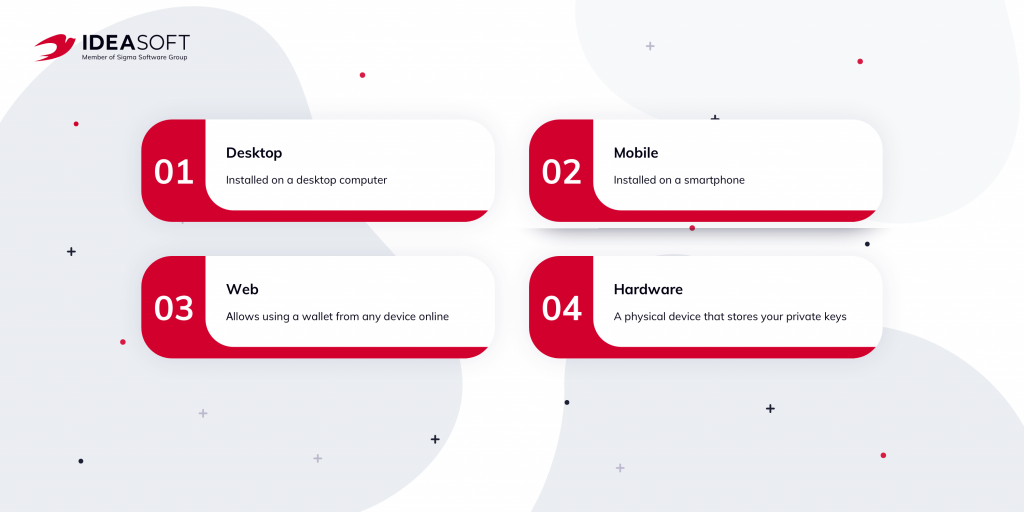
Finally, any DeFi application is based on a specific algorithm that triggers the authentication of transactions of network members. Be sure to check this task with a DeFi wallet development company that can help you create the best algorithms for your product.
UX/UI design
Would it surprise you to know that it is not enough to find interesting and useful features for an application? A more difficult task is to collect them into a single user-friendly interface. This is where UX/UI designers come in. UX/UI is about more than just creating the look and feel of your wallet. This stage involves the study of user behavior so that the logic of the application interface meets their expectations and needs. We have already mentioned that the poor UX of DeFi platforms is often one of the main reasons why users prefer centralized solutions. The design should become an integral part of DeFi wallet development.
If the designers are part of the development team, this can help design specialists and developers communicate closely which will greatly simplify and speed up the development process. For this reason we advise you to choose companies offering a full range of DeFi wallet development services. For example, the IdeaSoft team can cover a wide spectrum of tasks related to the creation of a DeFi product: from business analysis and design to programming, testing, and support.
Software development
After the stages of collecting information, building of the architecture, and design creation, we can proceed to the technical implementation of your project. To do this, engineers need to choose the technology stack that best fits the intended goals. The areas of focus should consist of programming languages, frameworks, libraries, databases, and other development tools. DeFi wallet development requires deep expertise in building decentralized solutions. As a product creator you need to make sure not only that the app is functional, but also that it is 100% secure and that users can trust it with their funds. Therefore, it is important to work with experienced blockchain developers who know all the features of writing smart contracts, building algorithms, and ensuring system security.
How can you develop a DeFi wallet providing high-grade security? Basic security features include the following:
- Two-Factor Authentication. A simple and reliable way to protect user accounts. By creating a unique one-time code for login, you ensure that unauthorized users don’t gain access to the wallet.
- Biometrics. Face ID and Touch ID will allow you to authenticate the user every time a cryptocurrency transfer request is generated. This way you can avoid unauthorized transactions.
- Multi-signature. This security feature requires more than one user signature to complete a transaction.
- Session Logout. If a user does not interact with the wallet for a pre-specified time, the session will end automatically. The time should be determined by a smart contract, and the smaller the amount of time it is, the less likely a fraudster will be able to use a valid session ID.
- And finally, don’t store users’ private keys on the system.

Testing
Software testing is one of the most crucial steps in the development process. It is a best practice to involve QA specialists at all stages of product development in order to not accumulate bugs. Testing the DeFi wallet is not limited to verifying that the features are working correctly and meeting the requirements of the project. You also need to make sure that the smart contracts underlying your application are secure and free from vulnerabilities. A smart contract audit is a complex process that requires a lot of experience, but you shouldn’t skip this step because your investment will be worthwhile.
Examples of DeFi wallets
If you want to create a high-quality and competitive product, it is not enough for you to know how to develop a DeFi wallet, you should, first of all, know what wallets are already on the market. This will help you identify competitors, study their strengths and weaknesses and come up with ideas of how your product can be better. Here are examples of some DeFi wallets and their killer features.
- MetaMask. Metamask is a web browser extension that is great for accessing DeFi platforms. It is also available in a mobile version. Metamask has easy integration with most DeFi protocols and supports ERC20 standard tokens, as well as Binance Smart Chain BEP-20 tokens.
- Coinbase Wallet. The already mentioned Coinbase Wallet refers to mobile DeFi wallets. It allows you to connect your wallet to your Coinbase account. Also, many users note the convenience of using this app. For example, you can make a transaction by entering a username instead of a long wallet address.
- Trezor. Trezor is a cold wallet with a great built-in security mechanism. One of the indispensable features of this wallet is the recovery seed. It allows you to restore access to your wallet if you have lost your device. All you need to do is to enter the words of the seed into your new Trezor device.
- Argent. Argent is focused on a mobile-first approach. It helps you easily access popular protocols like Aave and Compound. Argent has a special ‘Guardians’ feature that allows you to recover an account using people or devices you trust. All you need to do is add Guardians to your application, which can be a hardware wallet or a friend.
How we can help
Hopefully this article has given you a quick overview of how to develop a DeFi wallet. Of course, the implementation of each project involves a lot of nuances. If you want to get a solution that best suits your needs feel free to discuss your project with our specialists.
IdeaSoft provides a wide range of blockchain development services. The company portfolio consists of more than 250 successfully completed projects, including DeFi wallets, NFT marketplaces, crypto exchanges, lending/borrowing platforms, DeFi aggregators, and more. We have in-house business analysis and UX/UI design departments, as well as skilled blockchain developers on our staff. IdeaSoft has repeatedly been identified as one of the TOP blockchain development companies according to Techreviwer, Upvotes, and Clutch. Our clients note the high level of organization of business processes at IdeaSoft and the high level of professionalism of the team.
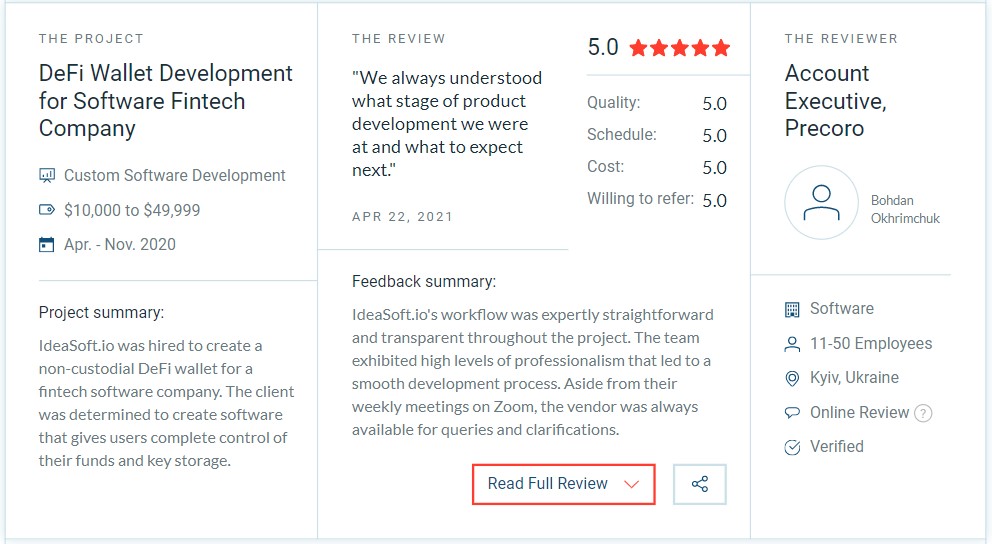
If you’re looking for a software development company with deep blockchain expertise, we will be happy to help you implement your project. By empowering your ideas with innovative technology, we will work together to bring the most exciting solutions to your business. Contact us today to have a discussion.
